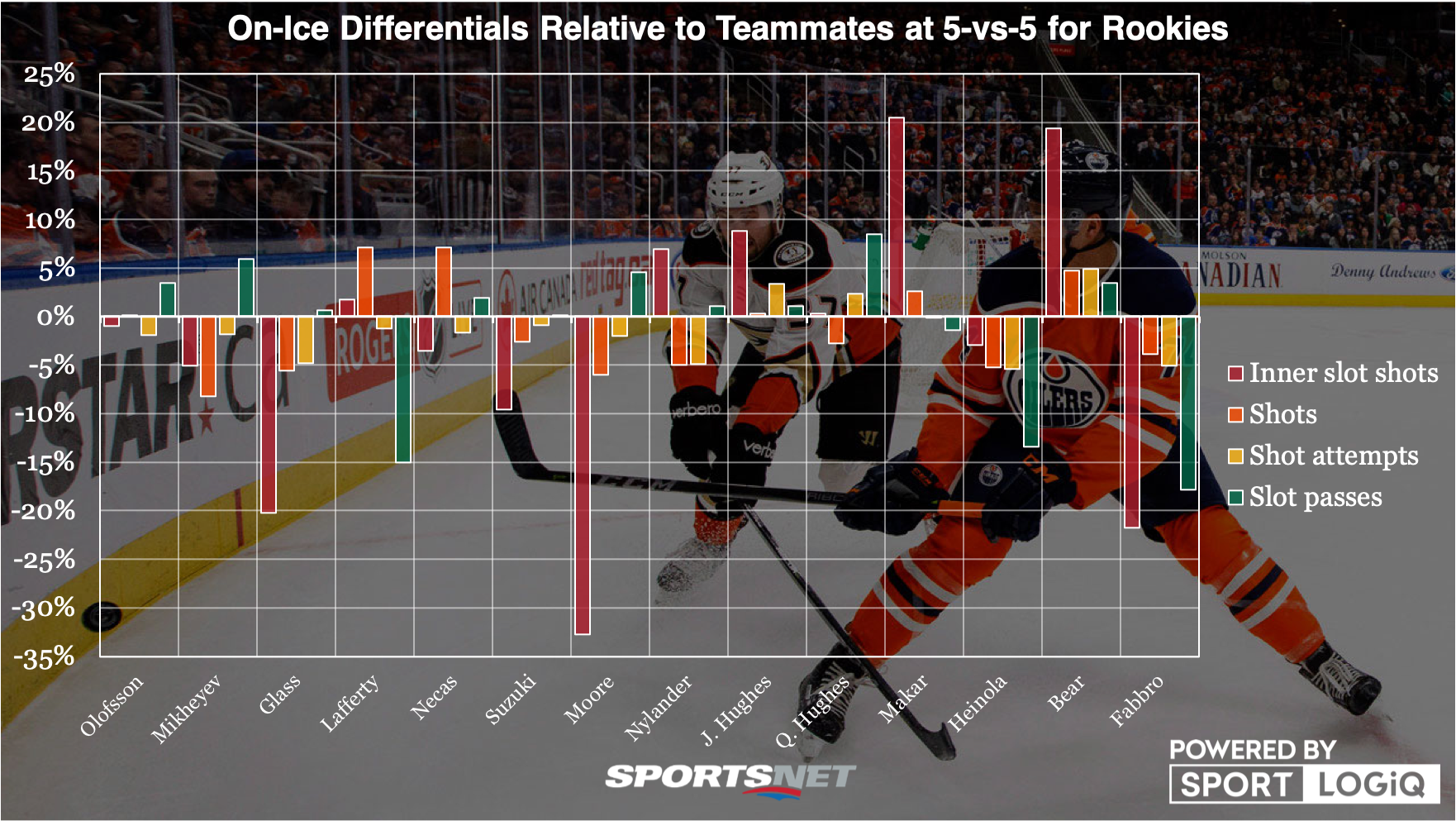Believe it or not, we’re through 15 per cent of all NHL games in the 2019-20 NHL regular season. A month in doesn’t seem like a lot, but a sizeable chunk of the season is already behind us, meaning it’s time to start checking in on this year’s crop of rookies.
Unlike recent years where there’s usually been a standout offensive star absorbing all the attention, this season’s group of new NHLers has a solid group of skaters all tied for the scoring lead, making it more difficult to see one player leading the way to the Calder Trophy so far.
This season’s rookies do boast some very impressive defencemen which we have to look at differently than forwards. But let’s separate the play drivers from the bunch first, then we can break down forwards and defencemen.

This one is a lot to take in, and unfortunately there are some serious graph breakers here (thanks Trevor Moore). The problem here is that there’s so little separation between the top rookies in the NHL this season, that I had to include a huge number of them in order to show whether they’re excelling or not.
In looking at all of this on-ice data, there are a few major takeaways to go over before we get into individual performances, but the most obvious one is that Ethan Bear is absolutely crushing it in Edmonton. He’s one of only two rookies who has uniformly positive differentials relative to his teammates, and he hasn’t been playing particularly sheltered minutes by any stretch. The Oilers desperately needed Bear to be NHL ready this year, and he’s proving to be arguably their best defenceman.
Bear is the leader of the pack on defence, but another observation you might make from looking at the numbers here is that Cale Makar has been crushing it in high danger chances. Makar is putting up similar relative numbers to Bear, but his is on top of a team that’s already dominating in that area, which means his raw differential is just … hard to believe. While Makar has been on the ice, the Avalanche have put 24 shots on net from the inner slot, and allowed just nine. That’s 72.7 per cent of all high danger chances being in the Avs’ favour while their rookie defenceman is skating. Crazy.
[snippet id=4748264]
Makar’s other numbers look less impressive on a relative scale, but don’t make the mistake of thinking he’s struggling; the Avalanche have just been stellar early. His team is controlling 55.4 per cent of the passes to the slot while he’s on the ice as well, so he’s not far behind Bear in on-ice impact, and he’s producing more points.
Right on the heels of the top two defencemen in the early going is Vancouver’s Quinn Hughes, who boasts positive relative differentials in every area except for shots on goal, which looks more like bad luck to me when everything else points to him being a positive impact player. Like Makar, Hughes has been ripping it up offensively, especially on the power play where he has been brilliant with a whopping eight points.
The only player aside from Bear who has managed to improve his team’s fortunes in every category in this young season has been Hughes’s younger brother, Jack, in New Jersey. While the defensive candidates are crowded together early this season, Hughes pretty much stands alone among the forwards.
Others have produced more than Hughes in points so far this year, but no other forwards have had close to his on-ice impact. He’s been involved in far more scoring chances both overall and per minute than any other rookie forward, while playing a bigger role due to necessity in New Jersey.
Jack Hughes is also transitioning the puck up the ice 20.2 times per 20 minutes of play at 5-vs-5, which ties him with Alex DeBrincat and Max Domi, two brilliant puck carriers who have huge impacts on their teams on top of the points they produce. It was a very slow start for him, but don’t be shocked if he keeps getting better as the season goes along.
Both Hughes brothers have great chances to take home the Calder this season if things keep going this way, but let’s not sleep on Bear, who is by far the leader here early in the season, and is doing things in a more subtle fashion than his competitors.
[snippet id=4167285]
Bear doesn’t have the power-play dominance that Quinn Hughes has, and he doesn’t have the dynamic skating and attacking ability that Makar does, but he does have incredibly puck moving ability through passing.
Bear is 24th in the NHL in completed defensive zone passes per minute played, and of the players who have completed more, only one has a better completion rate: Cam Fowler. When you look only at passes that create a zone exit, Bear moves up to sixth in the NHL, and again only Fowler is ahead of him in completion rate. Bear is a clinical operator who has allowed the Oilers to surprise everyone this season, exactly the kind of player they needed.
[relatedlinks]







